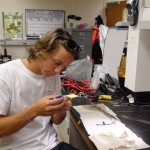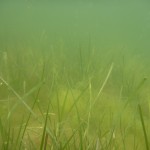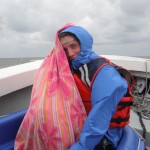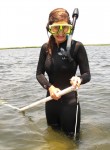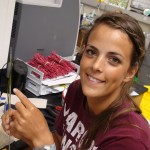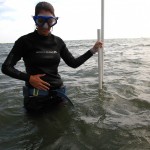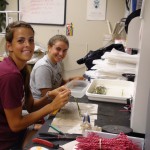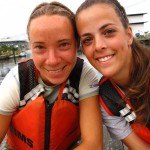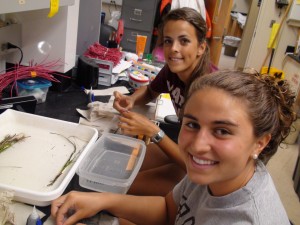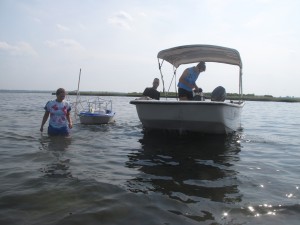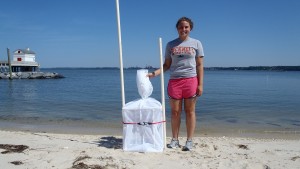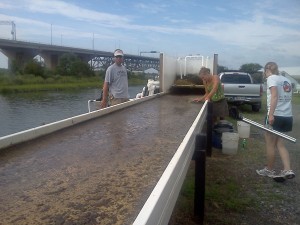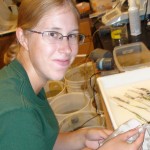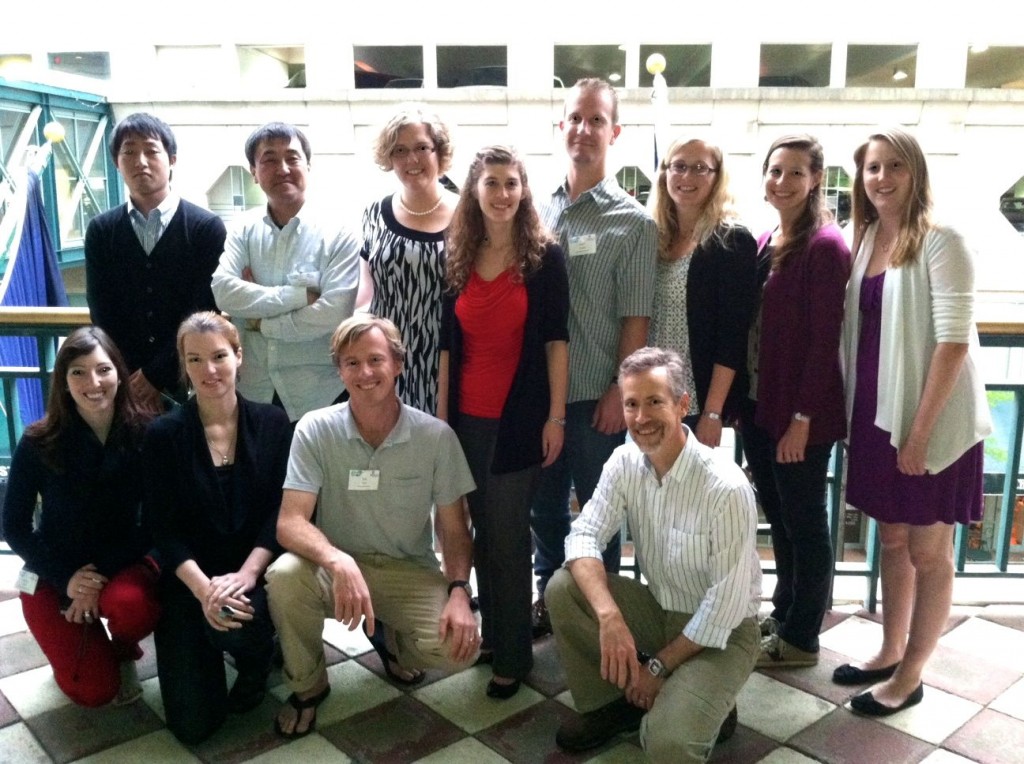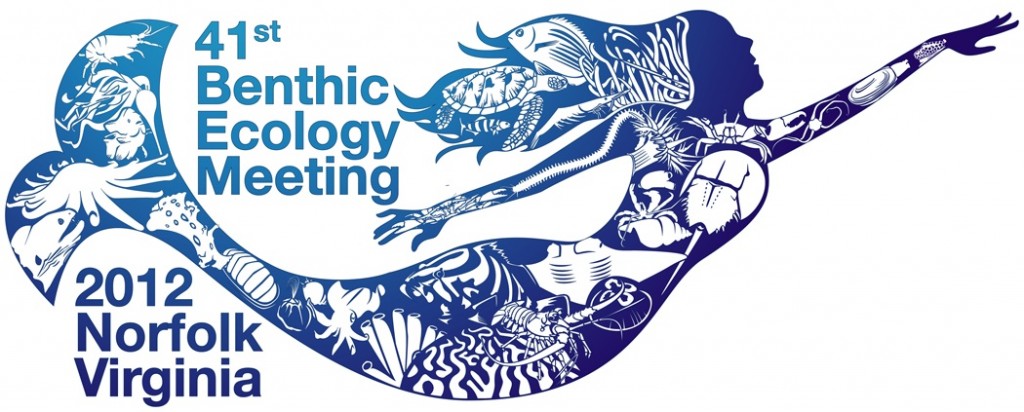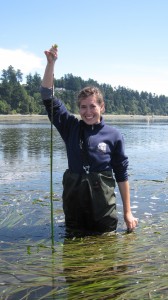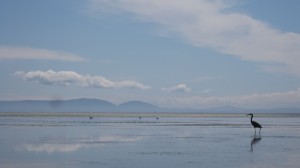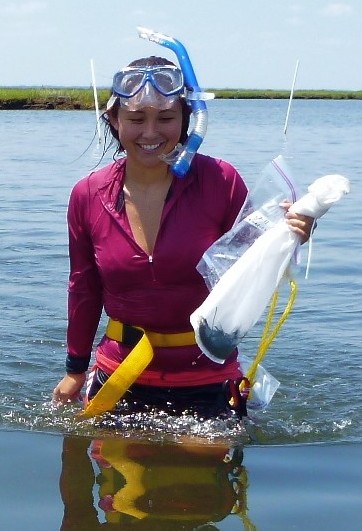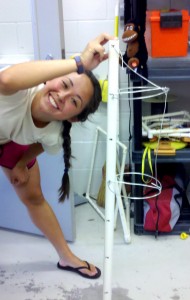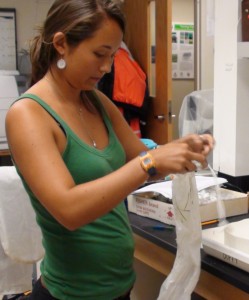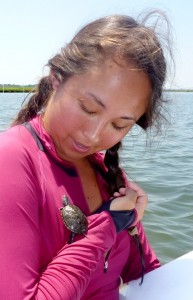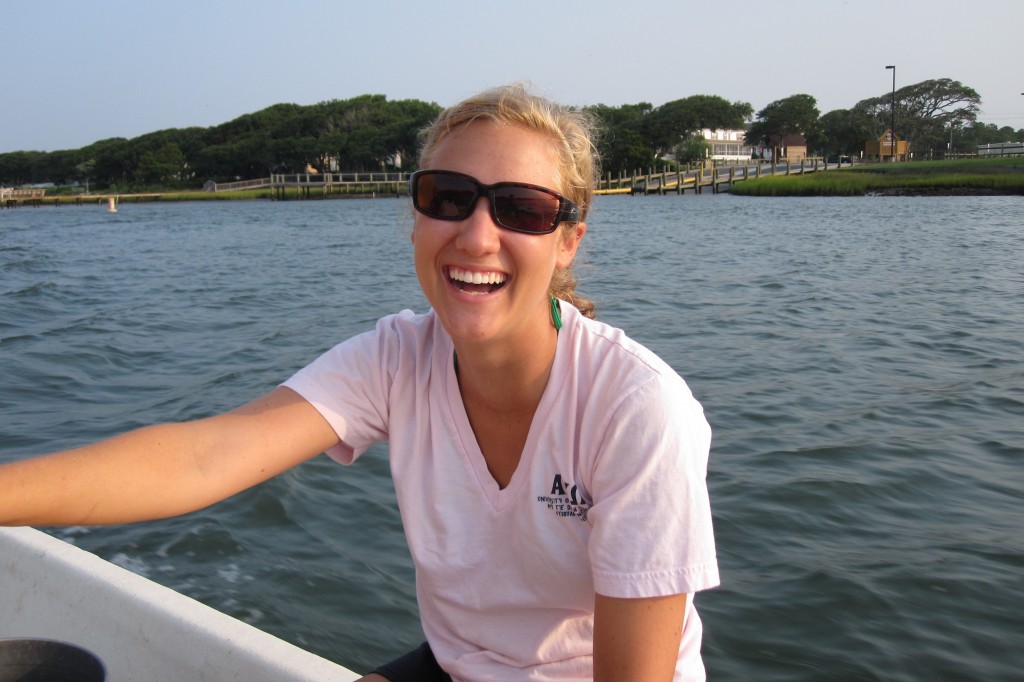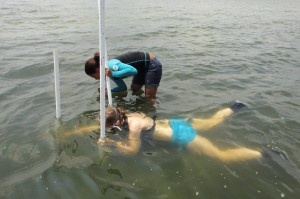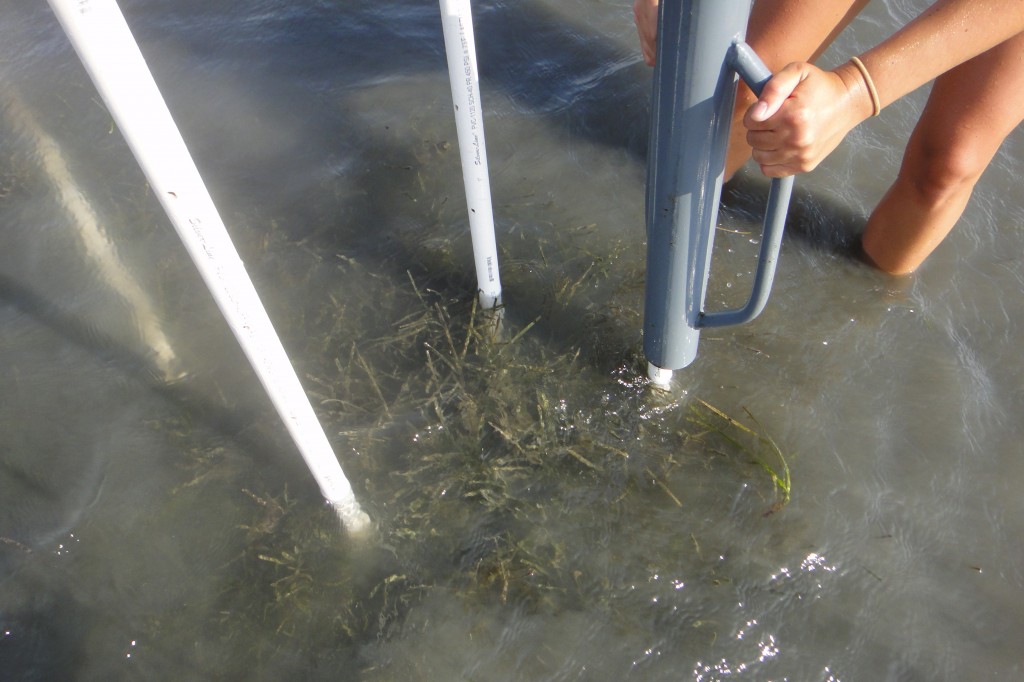The business of science
by John Schengber (VIMS undergraduate student summer intern)
I am an undergraduate at James Madison University and have been working this summer with the ZEN team at the Virginia Institute of Marine Science in Gloucester, Virginia. I have lived right across the river in neighboring Yorktown for most of my life. Surrounded by nature and adventure, I have become an outdoor kind of guy with an intense curiosity and respect for nature. I still have not decided the exact career path I want to take, so this summer was an excellent opportunity to explore research and marine biology.
I think most people in the lab were surprised when I revealed that I am in fact a business major. Everyone else around here studies (go figure) science. In the fall, I will be returning for my sophomore year at James Madison University, where I am pursuing a major in International Business coupled with a double minor in Spanish and Environmental Science. Now, why in the world would a business major be working in a science lab? First, let me emphasize that this career direction is not entirely definitive for me. I am fascinated by a myriad of fields of study. In business, I am drawn to the ideas of entrepreneurship and creativity, but not so much to the possibility of cubicle entrapment. I dream of running my own company, but am conflicted as business/industry can often be a driving force in the destruction of our natural world.
My love for science stems from my love for nature and the questions it begs us to answer. I am in constant awe of its wonder, and my life would be at loss if my studies lacked a good dosage of the biological sciences. Yet I love to interact with people (especially in Spanish), to solve problems, and to try new ideas in the business sector. So, I have come to a crucial intersection of interests. Business seems to be the last thing to enter if one is focused on saving the world from its own ruin. But I wonder if it can be done differently? Can we make a business that is not just sustainable but truly symbiotic with our environment? Most importantly, can this venture be profitable in a cut-throat capitalist economy? Lastly, can I be the person to do this? I have no idea. But I’d say it’s worth a shot.
So here I am at the Virginia Institute of Marine Science taking that first step. I came into this position with a few hopes and expectations. I wanted to check out the work of a marine biologist, which is my greatest love in science and the field that I would most likely enter if I decided to pursue a research career. I hoped that I would meet some incredible people with inspiring intelligence and personalities to match. I wanted to view the process of scientific investigation from beyond classroom instruction or media coverage. I wanted to learn a lot and experience even more. But really I just wanted to hang out with some amphipods.
All of my hopes and expectations have been fulfilled, and I have loved every minute of it. I have made new friends and linked up with old ones (see Nicole Rento’s post, fellow lab member this summer and best friend since, well, forever). I have learned more than I could have ever imagined. I have spent some quality time with lots and lots of amphipods. And I’ve learned that running a lab really isn’t too much different than running a business. There are budgets, deadlines, management, and lots and lots of ingenuity. Maybe there’s hope for me yet.
Calling all undergrads – get your hands on some science!
by Pamela Reynolds (ZEN Coordinator)
Calling all undergraduate students at the College of William and Mary, and surrounding colleges!
The Marine Biodiversity Lab at VIMS has several open positions this fall for research internships in marine ecology, evolution and biodiversity research. Students will receive hands-on research experience involving instruction in both laboratory and field techniques, as well as exposure to cutting-edge research being conducted in the Marine Biodiversity Lab at VIMS.
Research opportunities are in two areas: (1) Ecology of seagrass food webs, as part of the Zostera Experimental Network (ZEN, www.zenscience.org), and (2) Comparative ecology, evolution, and behavior of social shrimps from Caribbean coral reefs.
No experience is necessary, although we encourage applications from detail-oriented students with strong work ethic and communication skills.
Students will be instructed in the use of dissecting microscopes and other tools to identify and quantify local marine flora and fauna of the Chesapeake Bay and other estuaries (ZEN), or of Caribbean invertebrates. Students can expect to gain a strong working knowledge of the scientific process, basic taxonomy and ecological roles of marine organisms, and a greater understanding of fundamental ecological and evolutionary principles. Students will work closely with graduate students, postdoctoral researcher and staff scientists in the Marine Biodiversity Lab (http://www.vims.edu/research/units/labgroups/marine_biodiversity/index.php).
We are recruiting up to 5 students for these volunteer internship positions. Students may earn up to three course credits of MSCI 490 Research in Marine Science.
Students interested in working in this dynamic research environment should e-mail a copy of their resume and unofficial college transcript, with contact information for one WM faculty member who knows you, to both Drs. Pamela Reynolds (reynolds@vims.edu) and Emmett Duffy (jeduffy@vims.edu) to learn more about the position(s). If interested in course credit, contact us ASAP as the add deadline is fast approaching (Sept. 7th!).
The start of something new
by Katelyn Jenkins (College of William and Mary undergraduate)
My name is Katelyn Jenkins and I am a lab technician here at the Marine Biodiversity Lab at the Virginia Institute of Marine Science in Gloucester Point, Virginia. This year I will be a junior at the College of William and Mary where I am majoring in biology and minoring in marine science. As a local from Yorktown, Virginia, I have become fascinated with the environmental and economic importance of the world’s largest estuary just down the street – the Chesapeake Bay.
I became involved in research at VIMS during high school in 2008 where I worked in a Marine Conservation and Biology lab. Immediately immersed into field and laboratory work, I knew right away that marine science was a field I wanted to pursue. During 2009-2011 I began working on a research project at William and Mary that aimed to identify and characterize a harmful bacterium recently identified in striped bass in the Chesapeake Bay. Although the topic excited me, it wasn’t until I spent 2 years indoors running multiple PCR’s day after day in the lab that I knew I needed to get back into VIMS where I could study marine science on a much larger scale. In 2011, I began volunteering for Dr. Emmett Duffy in his Marine Biodiversity Lab where I learned to identify various types of seagrass, algae, and LOTS of what we affectionately call ‘bugs’ (small marine invertebrate grazers). Recently I put these new skills to the test when I returned to the lab to work as a technician for the summer.
This summer began on a busy note. I arrived at VIMS the day after I returned from a field course on the Eastern Shore. I had just enough time to unpack before I needed to repack my bags to head to Beaufort, North Carolina with our lab manager Paul Richardson to break down an experiment with the ZEN team at the University of North Carolina’s Institute of Marine Sciences (IMS). It was an exciting trip where I had the chance to meet and work with Erik Sotka and his lab group from the College of Charleston in South Carolina in addition to local NC graduate and undergraduate students. My first field experience with this lab group was an exciting one – there is a broad diversity of research projects and techniques employed in the ZEN. One of my favorite parts of the trip was having the chance to stay and work at IMS as well as learn about the ongoing research at this facility, as I have been thinking about potential graduate schools and programs to pursue after graduating from William and Mary.
After returning to VIMS, I have been involved in helping with many projects and picked up new skills: plumbing, sewing, processing chlorophyll samples, taking and sorting biomass cores, and preparing leaf tissue samples for CHN analysis. Although it may seem busy, it has forced me to become mentally organized with all of the different things going on in the lab – something that I think is a very important ‘life skill.’ I have also found that I have gained a lot of confidence in my abilities to recognize what needs to be done, when it needs to be completed by, and what needs to be done to have it completed. There’s a lot more to science than just doing research. I’ve learned that the planning, management and constant juggling of tasks is just as important as actually processing samples.
Melding biology and economics, an undergraduate perspective
by Nicole Rento (undergraduate student at Brown University)
My name is Nicole Rento, and I have been working at the Virginia Institute of Marine Science (VIMS) in Gloucester, Virginia with the ZEN team here this summer. I was born and raised in Virginia about 30 minutes away from VIMS in Newport News, where I attended elementary school through high school with fellow lab intern John Schengber. In a weird twist of fate, we both ended up coming home from our first year at different colleges (him at James Madison University and me at Brown University) to work in the Marine Biodiversity Lab. It’s been great working with one of my oldest and best friends, and making new ones here at VIMS.
I just finished my first year at Brown University, and I absolutely love it. I even enjoyed waking up at 6 A.M. most mornings for varsity swim practice, working in the library until late into the night, and especially everything in between. Heading off to college, I was really considering going into the field of medicine. Growing up with two surgeons as parents and listening to their work-related dinner conversations for 18 years, it was hard to imagine doing anything else with my love for biology.
Throughout my first semester at Brown, however, I began to move away from my thoughts of becoming a physician and the idea of having to take two semesters of organic chemistry and towards my love for the environment and ecology. And surprising myself by thoroughly enjoying an introductory economics class during the spring semester, I put myself on the path of double majoring in biology and economics. As to where that will take me, I’m not so sure. At the end of the semester I did know that I wanted to start figuring that out.
My advisor at Brown (Dr. Dov Sax) knows Dr. Duffy and put me in contact with him. I was delighted when he graciously and enthusiastically offered me an internship here in his Marine Biodiversity Lab. So here I am! I started in May, not sure what to expect nor whether I’d be able to see a path to integrate my two passions (biology and economics). I was introduced to the ZEN project on the first day, and have been working on different aspects of the ZEN projects every day since. The ZEN postdoctoral researcher Pamela Reynolds and the lab manager here Paul Richardson started off familiarizing me with the species we would be working with this summer. I learned about the biology and ecology of Zostera, the seagrass around which the ZEN project is formed, and all the animals that live within the habitat it forms including blue crabs, pipe fish, amphipods, gastropods, and isopods, to name a few of my favorites. I never thought I would see so many ‘bugs’ in one summer, let alone count and sort all of them. I’ve gotten pretty speedy at identifying these small invertebrate algae eaters.
I also never thought that I would become so experienced with PVC piping. One of my first tasks was to help Pamela and Paul design the cages for the predator exclusion portion of the project. Another unexpected job: John and I teamed up to make hundreds of plaster blocks for another part of the ZEN project. There were other tasks such as cutting circles of plastic Vexar, and bending hundreds of wires to be placed in the drying plaster blocks. Plaster, PVC piping, Vexar, wires… all for ecology? Yes. Although the connection was hard to find sometimes, as the cages and materials began to take shape, so did my first lesson in ecology: data don’t come out of thin air. First you have to collect those data, and to do that we had to run an experiment. That step came with trips out into the water – field days. I participated in both the set up and breakdown of an experiment to measure the effects of small predators (crabs, shrimp, fish) on seagrass communities. Working under the sun, holding your breath as we worked to secure our cages in murky water, it was no easy task. But seeing those 30 cages, all designed and built by the lab, helping us answer the important questions we ask with this project, was a feeling of incredible accomplishment for me and for my fellow lab members.
After running the experiment there comes countless (often tedious) hours of sample processing. My initial training in identifying seagrass species has come in very handy as we begin examining the final communities from our experimental cages. Finally, after the samples are sorted and the data collected, they have to be analyzed. But we aren’t there yet. I can’t wait to hear the stories from the other sites, and to see what happens as we begin to go through the data from our site’s experiment.
This summer has been a wonderful experience filled with bugs, PVC, great scientists and great friends. Working at VIMS this summer has not only reaffirmed my love for biology, but it has given me insight into the combination of biology with economics. During the summer I heard about other projects that had taken place in our lab and in others. One example was the research our lab did with algae as a biofuel. By running river water through giant flow tanks and back into the river, algae was able to grow on the tanks and remove excess nitrogen and phosphorus from the river water as it ran through the tank, returning cleaner water into the river. The algae could then be harvested and used as a biofuel. Not only is this a breakthrough biologically, but economically as well. In theory, if companies were to install these flow tanks in their factories, they could not only create their own naturally cleaner biofuel, but also help to clean river or lake water. Although still in the preliminary research and development phase, projects like these are beneficial to both the economy and to the environment, and I can definitely see myself being involved in similar projects in the future.
I’m so thankful for having the chance to work with the VIMS Marine Biodiversity Lab this summer. Good luck to the other sites!
Student profile: REU participant Caitlin
by Caitlin Fikes (VIMS summer 2012 REU student)
Greetings, fellow sea-lovers! My name is Caitlin Fikes, and I’m thrilled to be part of the ZEN family. I am an undergraduate student participating in the National Science Foundation’s REU (research experience for undergraduates) program this summer at VIMS. I’ve been asked how I became involved in the ZEN project and the type of background that makes for a competitive REU applicant. To answer that, let me tell you a little about myself.
I was born in the fine state of Virginia, although for all intents and purposes, this summer was the first time I’ve been here. Growing up my family felt the need to move when the wind changes; we breezed through Virginia and onto another state before I was old enough to remember a thing. I grew up in various states, and developed a love for change and travel and new experiences. I’ve never regretted my vagabond childhood for an instant, and I don’t intend to ever stop moving.
I have always loved nature and wildlife. As a child, I read every book on animals that I could get my hands on, and spent my days traipsing through the woods looking for snakes or deer tracks. But I didn’t know what direction I specifically wanted to go. I loved all nature, all animals, everywhere. When I was fifteen, I acquired my SCUBA certification, and it became very clear to me that I belong in the marine world. I resented the human limitations that required me to eventually come back to the surface for air. I would have remained underwater forever if I could, exploring and observing quite happily. My dream of becoming a marine biologist was born.
Other than obtaining the SCUBA certification itself, I took my first real step towards my dream in 2009, the summer before my senior year of high school. My family was living near Omaha, Nebraska, at the time, and the Henry Doorly Zoo in Omaha was offering a summer “Eco-Adventure” course. The program consisted of first working with various animals at the Zoo for two weeks, and then culminated in a week-long trip to Cozumel, where the group would be researching coral reefs and snorkeling alongside migrating whale sharks. Barely able to contain my excitement, I applied and was accepted. Caring for a myriad of different animals at the Zoo was extremely informative and fun, but when it came to my marine biology dream, the week in Cozumel sealed the deal for me.
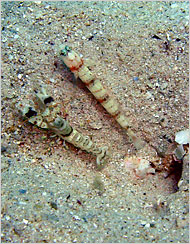
An example of the goby and shrimp pair (courtesy: Operation Pufferfish). To learn more, check out this NY Times page
And it wasn’t just about the charismatic megafauna; the dolphins and whale sharks were fantastic and all, but the highlight of the trip for me was discovering a tiny shrimp/goby pair while diving on the coral reef. I had read about the mutualistic relationship shared by shrimps and gobies, in which the blind shrimp digs a burrow for both to live in and the goby becomes a lookout and bodyguard. I thought it was incredible. To see a pair in the wild was exhilarating. The entire experience felt like a green light to pursue this ambition.
As soon as I returned from Cozumel, I used my connections from the program to obtain a volunteer internship at the Omaha Zoo’s Scott Aquarium. Throughout my entire senior year of high school, I spent every available hour at the aquarium, caring for and learning about the animals there, as well as observing the aquarium’s ongoing research. I learned that the Scott Aquarium was one of the first institutions in the world to successfully raise sexually produced elkhorn coral (Acropora palmata) polyps, a very important and highly threatened species of coral. To be so close to the cutting edge of marine biology research was an awesome opportunity; but I was eager to actually jump in and get my feet wet.
I began my college career at the University of Miami in 2010, double majoring in biology and marine science, and double minoring in chemistry and environmental science. Miami has given me a thorough grounding in biology, chemistry, and physics, with emphasis on marine science and exposure to incredible field and research experience probably not available to universities elsewhere. By the end of only two years as an undergrad, I had participated in field studies in coral reefs, seagrass beds, and mangrove forests. I had helped catch and attach satellite tags to pelagic sharks. I had even started my own research project looking at the effects of a common herbicide on the embryonic development of sea urchins, which I will be continuing in the fall. And, in my spare time, I became certified to assist in rescuing stranded marine mammals.
Throughout this time, I also began to better define my interests and which direction I wish to take in marine biology. I became interested in marine conservation biology, especially in light of the current global fisheries crisis. But even more than that, I am interested in how changes in a particular species can affect the entire ecosystem. What is the nature and strength of the many connections between species? How does tugging one strand shake the food web? And how do the non-biological elements factor into the equation? I realized that what I want to become is actually a marine ecologist.
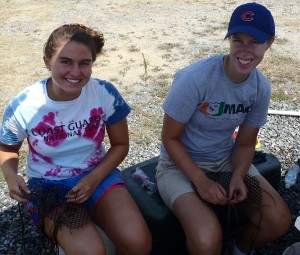
Undergraduates Nicole Rento (left) and Caitlin Fikes (right) prepare materials for a field experiment
Which brings me to this summer. Knowing that I wanted to do research, both to get more experience and to meet the people in my chosen field, I applied to the REU (Research Experience for Undergraduates) program here at VIMS. I was surprised and delighted to receive a call from Dr. Pamela Reynolds. When she told me that she felt I was a good fit for the Marine Biodiversity Lab under Dr. Emmett Duffy, I was honored, ecstatic, and extremely nervous!
Virginia and the Chesapeake Bay are gorgeous, VIMS is an incredible institution, and the members of the lab are both great people and great scientists. I would love to be able to follow in the footsteps of the skilled scientists who came before me, and every time we go flying out over the York River to our field sites for another fun day of science and adventure, I can’t help but feel that I’m on the right track.
ZEN at the 2012 Benthic Ecology Meeting
The Zostera Experimental Network (ZEN) team formally emerged into public view for the first time at the Benthic Ecology Meeting this past week in Norfolk, Virginia. ZEN coordinator Dr. Pamela Reynolds (top center in the photo, in red) presented a first look at the results of our 2011 experiment evaluating the relative importance of grazing, nutrient loading, and abiotic forcing on dynamics of eelgrass (Zostera marina) communities across the Northern Hemisphere.
ZEN had representation from several of our 15 global sites, and a diverse group of PIs, grad students and undergrads, at BEM this year. These included teams from northern Japan (PI Massa Nakaoka and grad student Kyosuke Momota), Quebec (graduate students Julie Lemieux and Laetitia Joseph), Massachusetts (PI James Douglass), North Carolina (PI Erik Sotka, grad students Rachel Gittman and Nicole Kollars, technicians Danielle Abbey and Alyssa Popowich), and Virginia (Emmett Duffy, Pamela Reynolds, Paul Richardson).
The abstract of Pamela’s presentation:
A comparative-experimental approach reveals complex forcing among bottom-up and top-down processes in seagrass communities across the Northern Hemisphere
Pamela L. Reynolds (1); Emmett Duffy (1); Christoffer Boström (2); James Coyer (3); Mathieu Cusson (4); James Douglass (5); Johan Eklöf (6); Aschwin Engelen (7); Klemens Eriksson (3); Stein Fredriksen (8); Lars Gamfeldt (6); Masakazu Hori (9); Kevin Hovel (10); Katrin Iken (11); Per-Olav Moksnes (6); Masahiro Nakaoka (12); Mary O’Connor (13); Jeanine Olsen (3); Paul Richardson (1); Jennifer Ruesink (14); Erik Sotka (15); Jay Stachowicz (16); Jonas Thormar (8)
(1) Virginia Institute of Marine Science, (2) Åbo Akademi University, (3) University of Gronigen, (4) Université du Québec à Chicoutimi, (5) Northeastern University, (6) University of Gothenburg, (7) Universidade do Algarve, (8) University of Oslo, (9) Fisheries Research Agency, Japan, (10) San Diego State University, (11) University of Alaska Fairbanks, (12) Hokkaido University, (13) University of British Columbia, (14) University of Washington, (15) College of Charleston, (16) University of California Davis
Two fundamental challenges to prediction in ecology are complexity and idiosyncrasy. How do we evaluate the importance and generality of multiple, interacting factors in mediating ecological structure and processes? One promising way forward is the comparative-experimental approach, integrating standardized experiments with observational data. In summer 2011 the Zostera Experimental Network (ZEN), a collaboration among ecologists across 15 Northern Hemisphere sites, initiated parallel field experiments exploring bottom-up and top-down control in eelgrass (Zostera marina) communities. Eelgrass is among the most widespread marine plants, forming ecologically and economically important but threatened coastal habitats. We factorially added nutrients and excluded small crustaceans (mesograzers) using a degradable chemical deterrent for four weeks, and measured responses of associated plant and animal communities. As expected, results varied strongly across the global range. Our cage-free deterrent strongly reduced crustacean grazers; at several sites grazer exclusion released blooms of epiphytic algae and/or sessile invertebrates. In Chesapeake Bay, these blooms reduced eelgrass biomass after eight weeks, demonstrating mutualistic dependence between eelgrass and mesograzers. Surprisingly, nutrient addition had little effect on epiphytes, except in Massachusetts and Sweden where grazers are suppressed by mesopredators. Ongoing research is analyzing the relative influence of grazer diversity and environmental forcing in mediating these processes.
Analysis of the 2011 experiments is still under way–even as we swing into high gear for planning the 2012 experiment. We will be presenting the complete results of the 2011 experiment at the Ecological Society of America meeting in Portland (August 2012) and the 47th European Marine Biology Symposium in Arendal, Norway (September 2012). We hope to see you at one or another of these events!
Typical day at the ZEN British Columbia field site
by Carolyn Prentice (Univ. British Columbia undergraduate at ZEN Vancouver, British Columbia Site)
My experience working on the ZEN project in Dr. Mary O’Connor’s lab this past summer was simply fantastic. It was great to have a summer job that I was really passionate about; anytime anyone asked me what I was doing for the summer, they were in for more than just a one-sentence answer! It was also great to share the experience with many other passionate biologists; we had an amazing group of workers and volunteers. Even when it was rainy and windy and our hands were numb, we knew we were lucky to be doing what we were doing! I am grateful to have had such an amazing opportunity, especially as an undergraduate and working on the ZEN project has certainly inspired me to continue studying the fascinating communities that inhabit Zostera marina beds. I am also excited to see the results of the ZEN projects from all of the different sites!
A typical day for the crew at the ZEN B.C. site:
1. Pile into the U.B.C. Zoology van with equipment and keen volunteers.
2. Arrive at the field site, put on (leaky) chest waders and sun hats or rain jackets (typically the latter).
3. Head down the 300 or so stairs to the beach, pass all of the locals getting their daily exercise and wearing ‘what are you guys up to’ looks on their faces.
4. Head out onto the mud flats, try not to stop moving or risk getting stuck in the really sticky mud.
5. Go about whatever task we had set out to do that day. Meanwhile, enjoy the beautiful scenery – the nearby Gulf Islands, the B.C. Ferries sailing across the Straight of Georgia, and hundreds of foraging herons.
6. Walk back up the 300 or so stairs (great exercise!)
7. Empty the leaky waders.
8. Go to Tim Horton’s to get iced caps or hot chocolates (typically the latter) before heading back to U.B.C.
9. Go home feeling like the luckiest people in the world!
A summer of adventure
By Akela Kuwahara, VIMS REU student summer 2011 (Humboldt State University)
Last week I earned my Invertebrate Zoology team at Humboldt State University 10 extra credit points for successfully identifying a gammaridean and caprellid amphipod, a mysid shrimp, and several Palmonetesshrimps! How, you ask? One word: ZEN.
This past summer I was in the REU program at VIMS working with Dr. Duffy’s Marine Biodiversity Lab. The ZEN project had just begun when I arrived in Virginia and I quickly set to work making experimental equipment and processing seagrass samples. Coastal Virginia looks nothing like the rocky California Coast where I currently go to school at Humboldt State University, nor like where I grew up on the Big Island of Hawaii.
I have had few experiences as enriching, educational, and career-focusing as my internship with the VIMS ZEN team. I had an up-close encounter with a juvenile terrapin who tried to nest in my hair, and an encounter with a sea nettle that wrapped my leg in a less than tender embrace. I became an expert at pouring cups of wet plaster, identifying a severed head or lone backside of the tiny amphipod Gammarus mucronatus, distinguishing between seagrasses Ruppia and Zostera, doing the sting-ray-shuffle, writing international UPS labels in the nick of time, and so much more.
Sadly, since my time at VIMS has ended, these skills have been poorly utilized. They have, however, given me a better understanding of marine ecology and the functioning of seagrass habitats, and they’ve earned me 10 extra credit points in Invertebrate Zoology! Emmett Duffy’s lab at VIMS is a craftily chosen group of people who have collectively helped to steer my interest in graduate studies towards subtidal ecosystems and their global presence and impact. I can’t wait to hear about where the ZEN is headed, and the progress that it has made. It was a summer well spent.
Photos by JE Duffy, PL Reynolds, JP Richardson
A ZEN-like beginning in North Carolina
By Megan Gyoerkoe, UNC Chapel Hill undergraduate student
One morning, bright and very early, the North Carolina ZEN team packed up the truck and with all the necessary materials for the initial set up of all 40 experimental plots for our experiment. We arrived at our field site behind the Pine Knoll Shores Aquarium and the weather was absolutely beautiful, sunny and warm but with a cool breeze. The tide was calm and the Zostera seagrass beds were vast and lush. After briefly meeting with the aquarium staff our group got started right away, driving the 120+ poles needed to mark the experimental plots into the sediment. About half way through Pamela began to check some of the plots to make sure they had enough Zostera (we were aiming for a minimum of 80% cover). As it turns out what we thought were lush beds of Zostera were actually composed mainly of a different type of seagrass – Ruppia! You can understand that this is a problem given that we are working on the Zostera Experimental Network (ZEN) and not, well REN!
We had spent all morning driving poles into the sediment only to discover that we had been deceived by the seagrass. In disbelief that we could have made such a mistake, we checked and double-checked the plots. Then we went on an extensive Zostera hunt, searching endlessly for a hint of a healthy Zostera bed, swimming through the seagrass even under the threat of being hit in the face by jumping mullets! Turns out it was all in vain and it was back to the drawing board for the ZEN-NC site. What had been an extensive Zostera bed two years before had been replaced almost entirely by Ruppia and some Halodule seagrasses. We spent hours pounding in the poles only to pull them back up the next day.
Fortunately, Pamela, Erik and Rachel were able to work out the logistics for us to work at a new site nearby in Middle Marsh that was actually filled with beautiful, lush Zostera. Even though we had to re-set all of the poles, it turned out to be a wonderful, protected site that was a pleasure to work in.
Field research is definitely a category on its own; it is pleasantly unpredictable, entertaining, exciting and occasionally slightly torturous. Continue Reading
This is science?
By Kara Gadeken, College of William & Mary undergraduate student
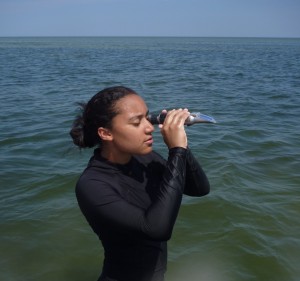
Undergraduate student Kara Gadeken takes water salinity measurements at Goodwin Islands, Virginia USA
Interning at VIMS during the hectic months when the ZEN project was at its peak was an experience that I will never forget.
The main reason that I wanted to take part in it was that, as an impassioned yet inexperienced college student, I had a reasonable knowledge base in biology but had no idea what it was like to actually do research, much less to be a part of such a grand-scale project as the ZEN. I approached Dr. Duffy at the suggestion of one of my professors at William and Mary, and luckily enough at this point his lab could use all of the help I could give.
I think the first thing that I realized while working in the Marine Biodiversity lab was that an insane amount of planning and preparation goes into research. Pamela had sticky notes and checklists and reminders all over everything in the lab, and two weeks of putting supplies together could count on one efficient day in the field. I also discovered that biologists, and especially experimental ecologists, almost have to have some engineering blood in them. In my first week at VIMS I sat in on a lab meeting to figure out how to design and construct cages to exclude predatory fish and crabs out in the seagrass beds. Time after time I heard, “How about this random thing? Hmm, I’m not sure that’ll work…How about this other random thing? Yeah, we can make something out of that!” Someone would hold up a piece of bent wire, some cable ties, bits of rope and mesh, some plastic plates. They hurled out idea after idea, trying to come up with something that could be constructed into a cage-like apparatus that would anchor into the sediment and withstand the waves. I remember stitching mesh together on an industrial sewing machine thinking, “This is science?” It didn’t take me long to realize that experiments are complicated. Not everything is perfect, and sometimes you have to work with what you’ve got, or make something new. Continue Reading

